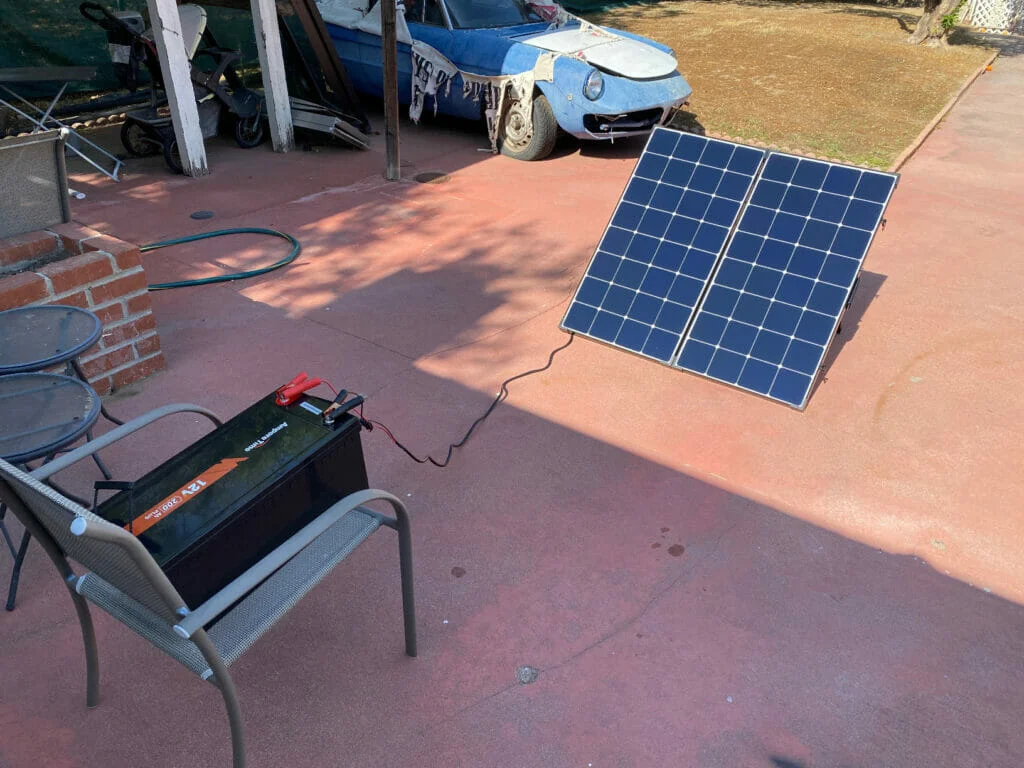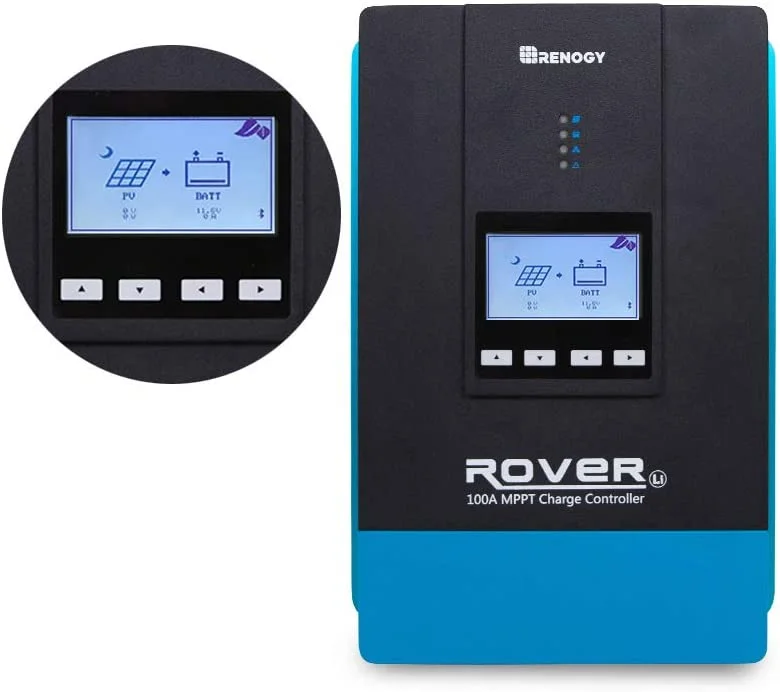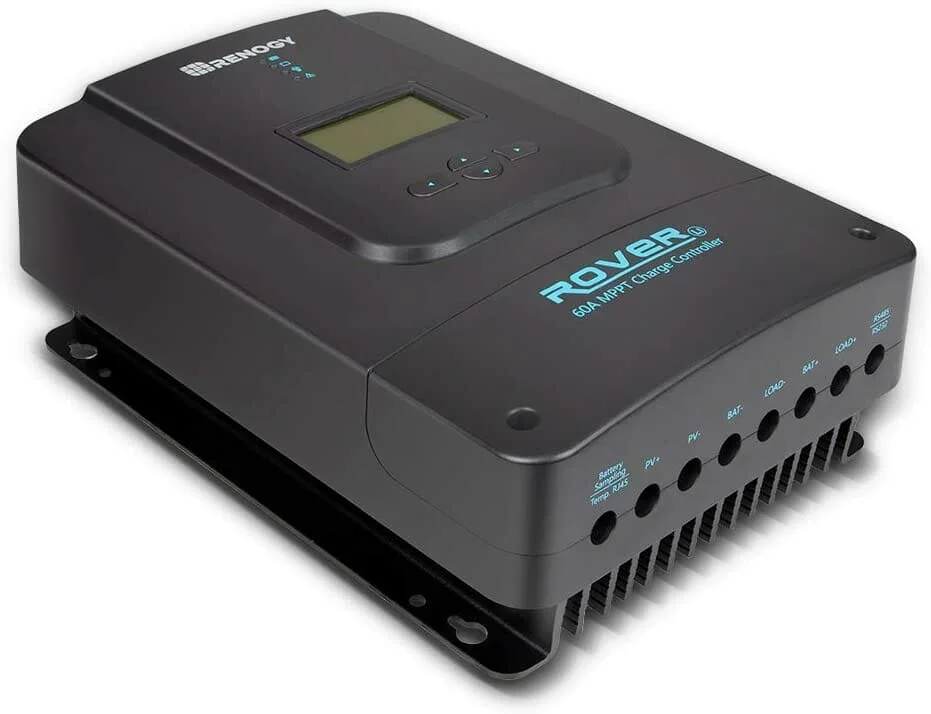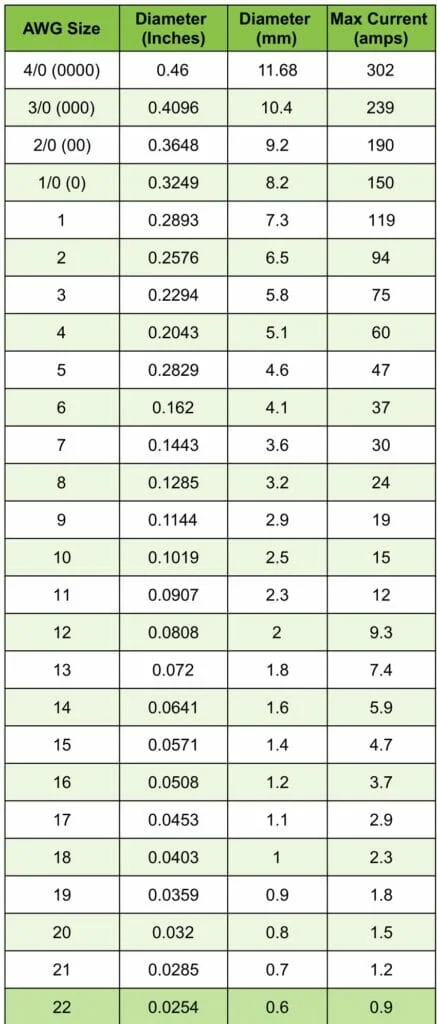Selecting the right size solar panel, charge controller, and wire size will allow you to recharge your 300Ah battery in desired hours.
This is going to be a complete guide on charging a 300ah battery with solar panels.
You'll learn:
- Solar Panel Required To Charge 300Ah Battery?
- What Are Solar Peak Sun Hours?
- Charging Different Type Batteries (Lithium, AGM, & Lead-acid)
- How To Calculate Number Of Solar Panels Required For 300Ah Battery?
- What Size Charge Controller For 300Ah Battery?
- What Size Wire To Charge 300Ah Battery?
- How to charge a battery from the solar panel (video tutorial)
Solar Panel Size Calculator For Battery
Note! Use this solar battery charge time calculator if you already have a solar panel in mind and want to know how long it will take to charge your battery.
Calculator Assumptions:
- Lead-acid Battery Charge efficiency rate: 85%
- AGM Battery Charge efficiency rate: 85%
- Lithium (LiFePO4) Charge efficiency rate: 99%
- PWM charge controller: 80% efficient
- MPPT charge controller: 98% efficient
- Solar Panels Efficiency during peak sun hours: 80% (meaning a 100 watt solar panel will produce 80 watts during peak sun hours, i’ll explain why…)
- Charge controller is the only load connected with the battery
How To Use The Calculator?
Enter the following info into the calculator ( located at the top of this page )
- Battery Capacity: Enter your battery capacity in amp-hours (Ah). in this case it'll be 300
- Battery Volts: is this a 12v, 24v, or 48v battery?
- Battery Type: Select the battery type, is this a lead-acid, AGM, or lithium-ion (LiFePO4) battery?
- Battery Depth of discharge DoD: is the percentage of the battery that has been discharged relative to the total battery capacity. for half discharged battery you’d enter 50, (if the battery is fully discharged which you can achieve on lithium battery, ENTER 100)
- Charge Controller Type: Are you using a PWM or MPPT charge controller to charge the battery?
- Desired Charge time (in peak sun hours): How fast would you like to charge your battery or how many peak sun hours your location receives? (keep reading i’ll explain how you can calculate the number of peak sun hours)
After entering the information, click “Calculate” button to find the required size for a 200ah battery.
Attention! Scroll down to the bottom of this page ( or click here ) to find out how you can calculate the size solar panel in future without any need of a online calculator.
Solar Panel Required To Charge 300Ah Battery?
Suppose you have a 12v 300ah lithium battery with 100% depth of discharge and an MPPT charge controller. You want to recharge your battery in one day (during summer days) and your location receives 6 hours of peak sunlight

You’d need about 730 watts of solar panels to fully charge a 12v 300ah lithium (LiFePO4) battery from 100% depth of discharge in 6 peak sun hours using an MPPT charge controller.
Read the below post to find out how fast you can charge your battery.
Related Post: Guide: Maximum Charging Current & Voltage For 12v Battery
What Are Solar Peak Sun Hours?
Before explaining peak sun hours and why to use them, first, let's see how solar panels are rated.
“ Solar panels are designed to produce their rated wattage output under standard test conditions – STC ”
STC includes:
- 1000 watts per meter square (1kw/m2) of sunlight intensity hitting the solar panels directly
- 25oC temperature
So to calculate the sunlight intensity we use peak sun hour as a reference.
- 1 peak sun hour = Average of 1kw/meter2 of sunlight intensity for one hour.
This number will depend on the location to location. To calculate how many peak sun hours your city receives use this PVwatt solar calculator.
Step 1: Enter your full address of just a city name & Click GO
Step 2: Click on results
Now you’d be able to see the total amount of solar radiation your location receives per day (from month to month)
Note! it would have to place my solar panels all day long under sunlight to get those total solar radiations per day.
Charging Different Type Batteries (Lithium, AGM, & Lead-acid)
Lead-acid, AGM, Gel, and lithium batteries are the most commonly used deep cycle batteries to store solar power or DC power.
Depth Of Discharge limit (DoD)
- Lead-acid batteries: 50%
- AGM: 50%
- Gel: 50%
- Lithium (LiFePO4): 100%
Lead-acid, Gel & AGM batteries Mostly have a DOD (depth of discharge) limit of 50%. Discharging them below 50% can permanently damage the battery cells and you won't be able to recharge them ever again
But on the other hand, you can discharge your lithium (LiFePO4) battery by 100% without causing any damage.
So if you have a lead-acid 300Ah battery then you'll be only able to use 150Ah which as result will be required less power to recharge them
Charging Efficiency
- Lead-acid batteries: 85%
- AGM: 85%
- Gel: 85%
- Lithium (LiFePO4): 98%
This means there will be on average 15% of power loss when charging lead-acid batteries and 2% when charging lithium batteries
How To Calculate Number Of Solar Panels Required For 300Ah Battery?

This is the most accurate way to calculate the required number of solar panels to charge any size battery.
Steps
1- Multiply the battery amp-hours (ah) by battery volts to convert the battery capacity into watt-hours (Wh). let's suppose you have a 12v 300ah battery
Battery capacity in Wh = 300 * 12 = 3600wh2- Multiply the battery watt-hours to the battery depth of discharge limit.
lead-acid, AGM, and gel batteries come with a 50% depth of discharge limit, and lithium batteries with 100% DoD. let's suppose you have a lead-acid battery
Discharged Battery capacity in Wh = 3600 * 0.5 = 1800wh3- Multiply the battery capacity after DoD by 1.15 for lead-acid and 1.01 for lithium battery ( Battery charge efficiency rate, lithium: 99%; Lead-acid: 85%; )
Power required to charge the battery =1800* 1.15 = 2070wh
4- Divide the battery capacity value (after charge adding efficiency factor) by the desired number of charge peak sun hours. let's suppose you want to recharge your battery in 5 peak sun hours
Solar power required in peak sun hour =2070/ 5 = 414 watts
5- Multiply the solar power required in peak sun hour by 1.2 if you're using a PWM charge controller and 1.02 for an MPPT charge controller ( charge controller efficiency, PWM: 80%; MPPT 98%; ). let's suppose you're using an MPPT charge controller
Solar power required after charge controller = 414 * 1.02 = 422 watts6- Add 20% to the solar power required after controller to cover up the solar panel inefficiency
Solar panel Required = 422 + 20% = 506 wattsWhat Size Charge Controller For 300Ah Battery?
Connecting solar panels directly to the battery can damage the battery cells due to the fluctuations in the solar panel voltage output.
The charge controller or regulator is the device that regulates the current and voltage coming from the solar panels to charge the battery
The capacity of charge controllers is measured in Amps (A). Which determines how many amps or current it can candle
Formula to calculate the size of a charge controller
Charge Controller Size = (Solar panels capacity (watts)/Battery Volts) + 25%
An extra 25% is added for safety reasons because at some point your solar panel will give output beyond its full capacity but it will last for a few seconds so to handle those fluctuations 25% is mandatory to add
(900/12) + 20% or *1.25 = 90ASo you would need a 100A Charge controller with 900-watt solar panels to charge your 12v 300Ah battery in 5 hours. My recommendations for the charge controller

100A MPPT charge controller (12V/24V/36V/48V)
Check Price (Amazon Link)

60A MPPT charge controller (12V/24V/36V/48V)
Check Price (Amazon Link)
PWM vs MPPT
- PWM charge controller
will only decrease the voltage coming from the solar panels and will not increase the amps (current).
which as a result will cause power losses and which makes the PWM charge controllers 20-30% less efficient.
The formula to power is... ( Watts = amps * volts )
Remember: a 12v solar panel will produce about 18 volts under direct sunlight conditions... and the amps will be lower.
Note! If you're using an PWM charge controller the voltage of solar panel and battery should be the same. ( eg. 12v solar panel for 12v battery and 24v solar panel to charge a 24v battery ). Otherwise you'll experience a huge power loss. If you have different voltage solar panels and battery then use an MPPT charge controller.
- MPPT charge controller
An MPPT charge controller will not only decrease the voltage coming from the solar panel to charge the battery but will also increase the amps to cover up the losses.
which makes them 98-99% more efficient than a PWM charge controller.
Pro Tip: if your solar panel system is higher then 100 watts then i would suggest using an MPPT charge controller.
Related Post: How Many Watts Can A Charge Controller Handle?
What Size Wire To Charge 300Ah Battery?

What size wire for solar panels chartYou would need the right size cable to handle the current coming from the solar panels to the charge controller and then from the charge controller to the battery
In the above chart, the size of the wire is mentioned as AWG size and how many amps or current it can handle is mentioned on the very right side
To make things more simple use this formula
Amps = Watts/Battery Volts
For example:
- 900 watts/12v = 75A
- 450 watts/12v = 37.5A
You would need 3 AWG wire size to charge a 12v 300Ah battery with 900 watts of solar panels
300Ah Battery Capacity In Watts
- 12v 300Ah battery is equal to 3600 watts or 3.6kWh
- 24v 300Ah battery is equal to 7200 watts or 7.2kWh
- 48V 300Ah battery is equal to 14,400 watts or 14.4kWh
Video – How To Built a Solar Power System To Charge a Battery
Related Posts
- 300Ah Battery Backup Time: How Long It Will Last?
- Solar DC Watts To AC Watts Calculator & Formula
- Amps To Watts Calculator: How Many Watts In A 12-volt Battery?
- Solar Panel Size Calculator For Battery
I hope this guide was helpful to you. still, have any confusion? LEAVE A COMMENT or contact us. Thank You!



